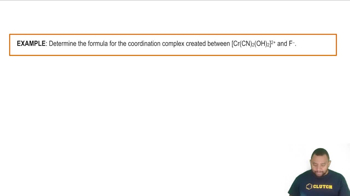CuI, CsI, and NaI each adopt a different type of structure. The three different structures are those shown in Figure 12.26. (a) Use ionic radii, Cs+ 1r = 1.81 A 2, Na+ 1r = 1.16 A 2, Cu+ 1r = 0.74 A 2, and, I- 1r = 2.06 A 2, to predict which compound will crystallize with which structure.
Ch.12 - Solids and Modern Materials

Brown14th EditionChemistry: The Central ScienceISBN: 9780134414232Not the one you use?Change textbook
Chapter 12, Problem 66b
The coordination number for the Al3+ ion is typically between four and six. Use the anion coordination number to determine the Al3 + coordination number in the following compounds: (b) Al2O3 where the oxygen ions are six coordinate.
 Verified step by step guidance
Verified step by step guidance1
Identify the coordination number of the oxygen ions, which is given as six.
Understand that the coordination number of Al^{3+} will be determined by the number of oxygen ions it is bonded to.
In Al2O3, each Al^{3+} ion is surrounded by oxygen ions. Since the oxygen ions are six-coordinate, each oxygen is bonded to multiple Al^{3+} ions.
Calculate the total number of Al^{3+} ions that can coordinate with one oxygen ion, considering the stoichiometry of Al2O3.
Determine the coordination number of Al^{3+} by considering how many oxygen ions surround each Al^{3+} ion, ensuring the charge balance and stoichiometry are maintained.

Verified video answer for a similar problem:
This video solution was recommended by our tutors as helpful for the problem above.
Video duration:
3mWas this helpful?
Key Concepts
Here are the essential concepts you must grasp in order to answer the question correctly.
Coordination Number
The coordination number refers to the number of ligand atoms that are bonded to a central metal ion in a complex. It is a crucial concept in coordination chemistry, as it influences the geometry and stability of the complex. For example, a coordination number of six typically leads to an octahedral geometry, while four can lead to either tetrahedral or square planar arrangements.
Recommended video:
Guided course

Coordination Numbers
Aluminum Ion (Al3+)
The aluminum ion, Al3+, is a common cation in coordination compounds, characterized by its +3 charge. This high charge density allows it to attract and coordinate with multiple anions or ligands. Understanding the properties of Al3+ is essential for predicting its behavior in various compounds, including its coordination number and the resulting structure.
Recommended video:
Guided course

Ion Formation
Anion Coordination
Anion coordination refers to the arrangement and bonding of anions around a central cation in a compound. The coordination number of the anions can influence the overall structure and stability of the compound. In the case of Al2O3, where oxygen ions are six-coordinate, this indicates that each aluminum ion is surrounded by six oxygen ions, which helps determine the coordination number of the aluminum ions.
Recommended video:
Guided course

Coordination Complexes Example
Related Practice
Textbook Question
1211
views
Textbook Question
The coordination number for the Al3+ ion is typically between four and six. Use the anion coordination number to determine the Al3 + coordination number in the following compounds: (a) AlF3 where the fluoride ions are two coordinate.
1147
views
1
rank
Textbook Question
The coordination number for the Al3+ ion is typically between four and six. Use the anion coordination number to determine the Al3 + coordination number in the following compounds: (c) AlN where the nitride ions are four coordinate.
1240
views
